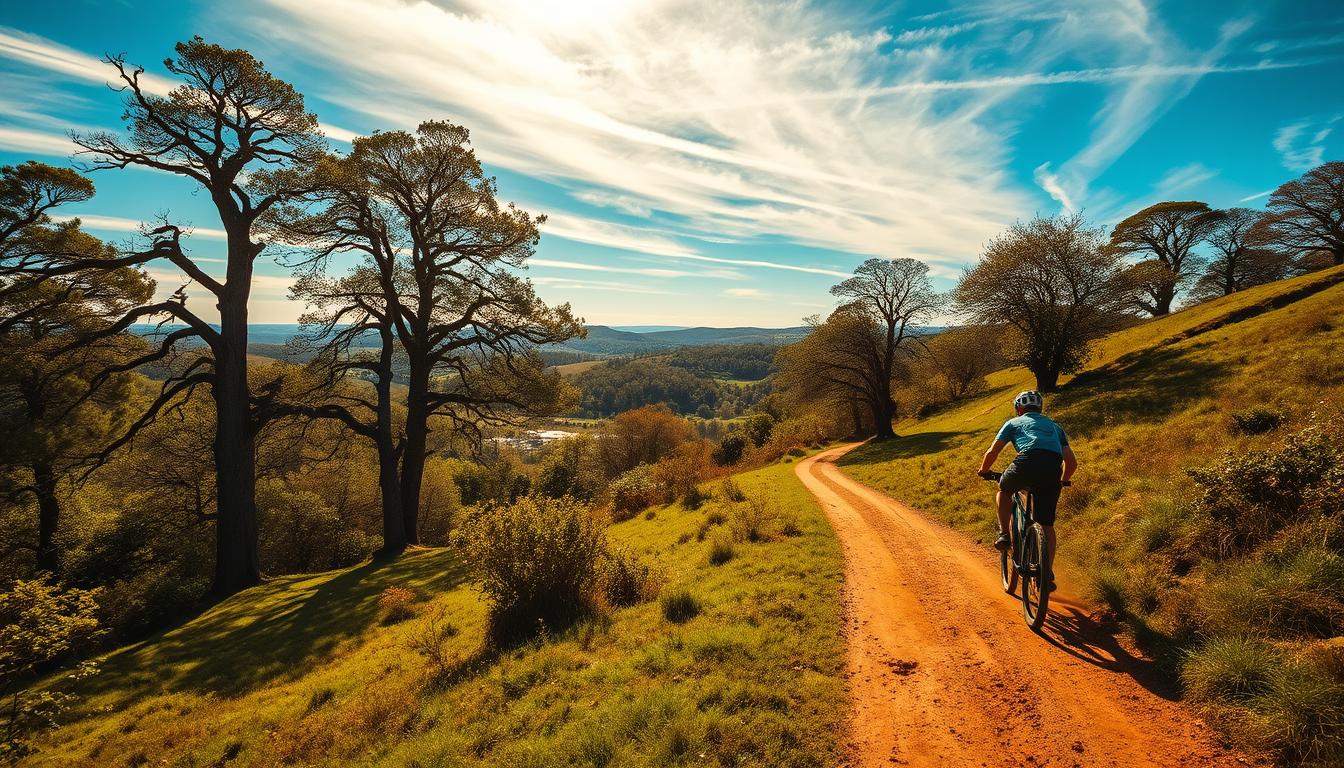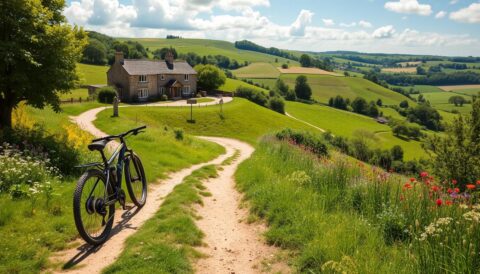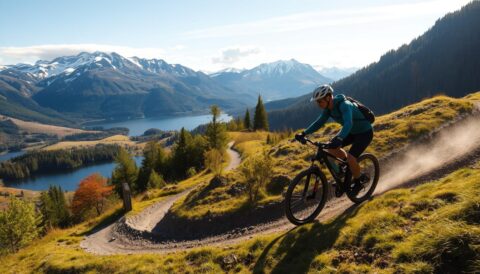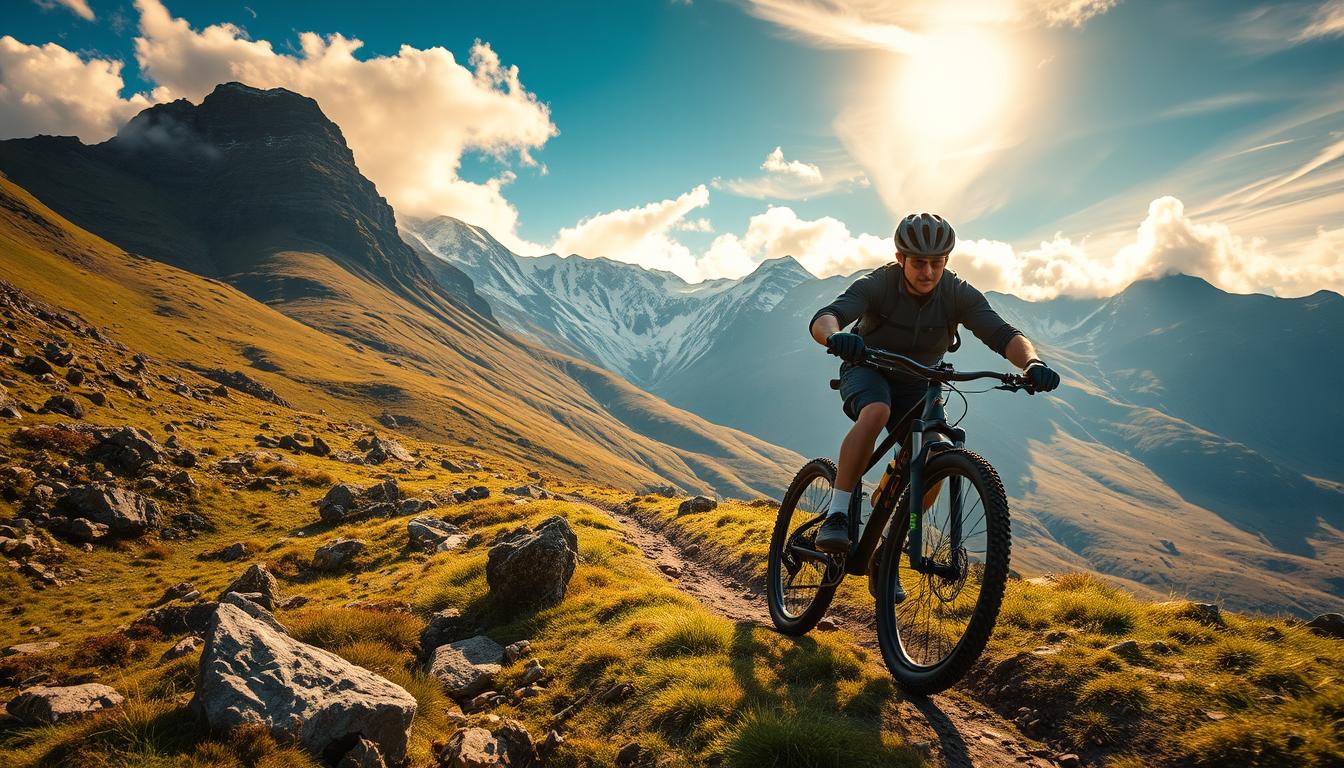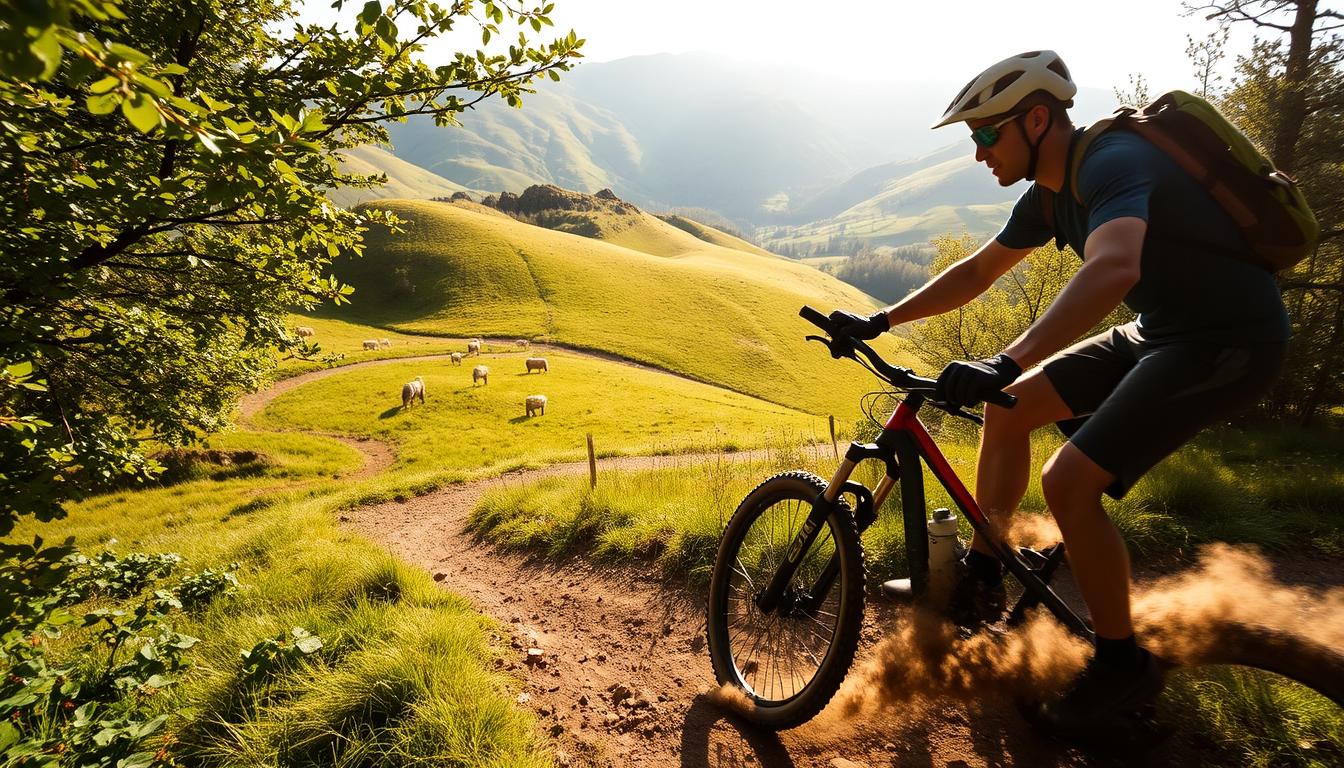Stretching 185 miles, the Thames Path is a National Trail that offers a remarkable blend of history and adventure. While primarily known as a walking route, it also features sections perfect for cyclists. This makes it a versatile choice for those seeking a mix of urban and rural landscapes.
With five official cycling sections totalling 37 miles, and an alternative 99-mile route from Woolwich to Oxford, there’s something for everyone. Whether you’re a casual rider or an experienced cyclist, the path provides a range of challenges and scenic rewards.
From the Cotswolds to the heart of London, the trail showcases diverse terrains and historic landmarks. Its UNESCO World Heritage Site connections add a cultural dimension to the journey. Year-round accessibility ensures you can enjoy it in any season, though weather conditions may vary.
Key Takeaways
- The Thames Path spans 185 miles, combining history and diverse terrains.
- It features five official cycling sections, totalling 37 miles.
- An alternative 99-mile route from Woolwich to Oxford is available.
- Suitable for both casual riders and experienced cyclists.
- Offers a mix of urban and rural landscapes.
- Accessible year-round, with seasonal considerations.
- Includes UNESCO World Heritage Site connections.
Introduction to Mountain Biking the Thames Path
Cycling along the Thames Path offers a unique way to explore England’s scenic landscapes. This National Trail stretches 185.2 miles, from Trewsbury Mead to the Thames Barrier, and is a favourite among walkers and cyclists alike. While primarily a walking route, it features dedicated sections perfect for cycling, making it a versatile choice for adventurers.
The route is a mix of surfaces, with 40% tarmac, 35% compact gravel, and 25% grass or riverside meadows. This variety ensures a dynamic experience, whether you’re a casual rider or an experienced cyclist. For those planning a longer journey, covering 12-18 miles daily is recommended to balance effort and enjoyment.
Moderate fitness is essential for tackling the full route, but shorter sections are accessible to most. Depending on your pace, completing the entire trail can take 7-10 days, while shorter sections can be enjoyed over 1-5 days. Along the way, you’ll encounter historic 14th-century bridges, royal estates, and stunning nature reserves, adding a cultural and natural dimension to your ride.
One of the unique aspects of this route is its connection to the English Coast Path, creating a 374km ‘Source to Sea’ journey. Accessibility is another advantage, with major transport hubs like London Waterloo, Reading, and Oxford providing easy entry points.
While summer (May to September) is ideal for cycling, shoulder seasons are also possible with proper preparation. Keep in mind that the path is shared with walkers, so caution is advised. Seasonal weather conditions can also affect your journey, so plan accordingly to ensure a safe and enjoyable experience.
Preparing for Your Ride
Proper preparation ensures a smooth and enjoyable ride along scenic routes. Whether you’re planning a short trip or a multi-day adventure, having the right equipment and knowledge is essential. This section will guide you through choosing the right bike and packing the necessary gear for a safe and memorable journey.
Choosing the Right Bike
Selecting the right bike depends on the terrain and distance you plan to cover. For mixed surfaces, a hybrid or gravel bike is ideal. These bikes handle tarmac, gravel, and grass with ease, making them perfect for varied routes. Ensure your bike is well-maintained, with brakes, tyres, and gears checked before you set off.
Essential Gear and Safety Tips
Cyclists should always prioritise safety. A ANSI-certified helmet, high-vis vest, and emergency whistle are mandatory. Additionally, carry a multitool, spare inner tubes, and a pump for quick repairs. For navigation, OS Explorer Maps 170, 171, 172, 173 are highly recommended.
Weather can change quickly, so pack a lightweight waterproof jacket and emergency blanket. For navigation, apps like Komoot or OS Maps are invaluable. In remote areas, such as the stretch between Newbridge and Oxford, carry a fully charged phone and inform someone of your route.
Wildlife precautions are also important. Adders are active in Chimney Meadows from April to October, so stay alert. In urban areas, use a Sold Secure Gold standard lock to secure your bike during stops.
| Item | Purpose |
|---|---|
| ANSI-certified helmet | Head protection |
| High-vis vest | Visibility in low light |
| Emergency whistle | Signalling for help |
| Multitool | Quick repairs |
| OS Explorer Maps | Navigation |
Finally, check the EA Floodline for tide updates, as 15% of riverside paths are affected by tides. With the right preparation, your ride will be both safe and enjoyable.
Best Routes for Mountain Biking the Thames Path
Exploring the best routes along this trail offers a mix of adventure and scenic beauty. Each section provides unique challenges and rewards, making it ideal for riders of all levels. Below, we highlight three standout routes that showcase the diversity of this iconic trail.
Godstow Bridge to Oxford Ring Road
This 11-mile route is perfect for advanced riders. It features a ferry crossing, adding an exciting element to the journey. The terrain is varied, with 40% single-track, 30% gravel, and 30% tarmac. Coordination with the tide timetable is essential for ferry operation.
Technical features, such as root networks near Bushy Park, make this route challenging yet rewarding. Night riding is also an option, thanks to reflective path markers.
Reading Bridge to Sonning
This part of the trail is ideal for a leisurely day ride. The route passes through picturesque landscapes and historic landmarks. It’s a great choice for those looking to enjoy the scenery without too much technical difficulty.
Shepperton Ferry to Teddington Lock
This section offers a blend of natural beauty and royal history. Riders pass through the grounds of Hampton Court Palace, once Henry VIII’s hunting grounds. The terrain is a mix of gravel and tarmac, suitable for intermediate riders.
| Route | Distance | Terrain |
|---|---|---|
| Godstow Bridge to Oxford Ring Road | 11 miles | 40% single-track, 30% gravel, 30% tarmac |
| Reading Bridge to Sonning | 8 miles | Mostly tarmac |
| Shepperton Ferry to Teddington Lock | 7 miles | Gravel and tarmac |
Cycling Tips for the Thames Path
Cycling along this iconic trail requires careful planning to handle its diverse conditions. Whether you’re a beginner or an experienced rider, these tips will help you make the most of your journey.
Navigating Shared Paths
This trail is popular with walkers and cyclists alike, so sharing the space respectfully is essential. Always signal your presence with a bell or friendly call when approaching others. Stick to the left to allow smooth passing, especially on narrow sections.
During busy days, patience is key. Slow down in crowded areas and be mindful of children or pets. Reflective gear is a must for night rides, ensuring visibility for everyone.
Dealing with Weather and Terrain
The trail’s conditions can vary significantly depending on the season. In winter, up to 8% of the path may close due to flooding, so check trail condition hotlines before setting off. Clay-heavy sections can become muddy; wider tyres and mudguards are highly recommended.
Summer brings its own challenges, with a trail hardness index of 3.5/5. Heatwaves require extra precautions—plan water stops every 5 miles and wear breathable clothing. Exposed estuary sections can be windy, so lean into the breeze and maintain a steady pace.
For night rides, ensure your bike has proper illumination. Front and rear lights are essential, and consider additional reflectors for added safety.
- Mud management: Use wider tyres and mudguards for clay-heavy sections.
- Heatwave precautions: Hydrate frequently and wear breathable clothing.
- Wind strategies: Lean into the breeze and maintain a steady pace.
- Night riding: Equip your bike with front and rear lights.
- Trail updates: Check hotline numbers for real-time conditions.
By following these tips, you’ll be well-prepared to tackle any part of the trail, regardless of the level of challenge it presents. Happy cycling!
Must-See Sights Along the Way
The trail offers more than just a ride; it’s a journey through history and nature. Along the way, you’ll encounter a mix of historic landmarks and stunning natural beauty spots. These sights add depth to your adventure, making every mile memorable.
Historic Landmarks
This route is rich in history, with landmarks that tell stories of the past. From 14th-century bridges to royal estates, each stop offers a glimpse into Britain’s heritage. Lechlade, for instance, is known for its picturesque church and charming market town atmosphere.
Another highlight is Marlow Bridge, a stunning suspension bridge that’s perfect for sunset photography. Its elegant design and riverside location make it a favourite among visitors.
Natural Beauty Spots
Nature lovers will find plenty to admire along the trail. Chimney Meadows, a Site of Special Scientific Interest (SSSI), is famous for its peak bluebell displays in late April. The area transforms into a sea of blue, creating a magical setting.
Rainham Marshes is another gem, especially for birdwatchers. Wintering bird populations flock here, offering a unique wildlife experience. Autumn brings vibrant foliage to Cliveden Woods, where corridors of golden leaves create a breathtaking scene.
| Spot | Feature |
|---|---|
| Chimney Meadows | Peak bluebell displays (late April) |
| Rainham Marshes | Wintering bird populations |
| Cliveden Woods | Autumn foliage corridors |
| Lechlade | Otter spotting and historic charm |
For those interested in guided experiences, nature walks are accessible from several cycling routes. These walks provide deeper insights into the area’s flora and fauna, enhancing your connection with the landscape.
Where to Stop for Refreshments
Taking a break during your ride is essential, and the trail offers plenty of cyclist-friendly spots to recharge. With 34 pubs equipped with bike racks, you’ll find convenient places to rest and refuel. Whether you’re craving a hearty meal or a quick snack, there’s something for everyone.
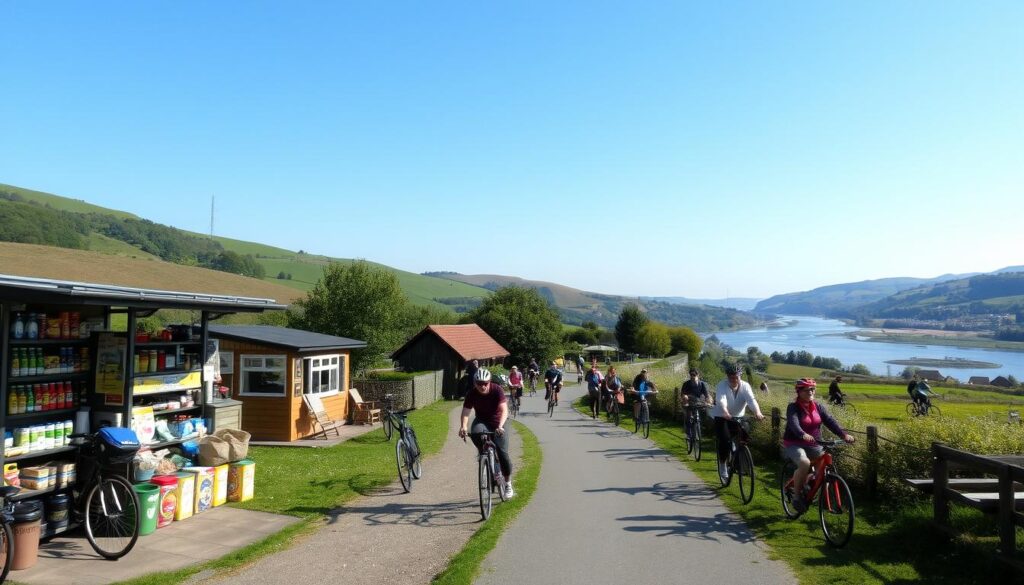
For those needing a quick tune-up, Velo Life Café in Wargrave provides a mechanic service alongside its delicious coffee. Meanwhile, The Nag’s Head stands out with its riverside bike wash station, perfect for cleaning up after a long day on the trail.
Here are some top-rated pit stops to consider:
- The Flower Pot in Bourne End – known for its hearty meals and cosy atmosphere.
- Lockkeeper’s Hut kiosks – budget-friendly options for a quick bite.
- The Herbivore in Richmond – a vegan-friendly café with a diverse menu.
- Dickensian pubs in Dorchester – themed stops offering a unique experience.
Water refill stations are mapped every 3 miles, ensuring you stay hydrated throughout your journey. These facilities make it easy to plan your days without worrying about running out of essentials.
| Stop | Feature |
|---|---|
| The Flower Pot | Hearty meals and cosy atmosphere |
| Lockkeeper’s Hut kiosks | Budget-friendly options |
| The Herbivore | Vegan-friendly menu |
| Dickensian pubs | Themed experience |
Whether you’re stopping for a quick coffee or a leisurely meal, these places ensure your ride is as enjoyable as it is memorable. Plan your breaks wisely to make the most of your adventure.
Public Transport and Accessibility
Getting around the trail is made easy with excellent public transport links. Over 92% of the route is within two miles of a train station, making it highly accessible for cyclists. South Western Railway’s bike reservation system ensures you can plan your journey with confidence.
For those starting near London, Santander Cycles docking stations are available near Putney Bridge. This provides a convenient option for short rides or connecting to other parts of the city. Multi-modal journey planning is simple, with apps like Citymapper offering real-time updates.
Transport for London (TfL) services are cyclist-friendly, with clear bike carriage policies. Adaptive bikes are available at accessible cycling hubs, ensuring everyone can enjoy the trail. Park & Ride facilities at key trailheads make it easy to combine driving and cycling.
In case of emergencies, extraction points are strategically placed along the route. These ensure injured riders can receive assistance quickly. Always check local transport updates before setting off to avoid disruptions.
| Feature | Details |
|---|---|
| Train Stations | 92% of route within 2 miles |
| Bike Reservation | South Western Railway system |
| Santander Cycles | Docking near Putney Bridge |
| Adaptive Bikes | Available at cycling hubs |
| Park & Ride | Facilities at trailheads |
Whether you’re planning a short ride or a multi-day adventure, the trail’s accessibility features make it a stress-free experience. Enjoy the journey with the peace of mind that transport and support are always within reach.
Conclusion
Exploring this iconic route is a great way to experience diverse landscapes and rich history. Before setting off, ensure you’re well-prepared with safety gear and a well-maintained bike. Combining cycling with walking sections can add variety to your adventure.
For those seeking a challenge, the annual Thames Path Cycling Challenge is a fantastic event to test your skills. If you’re looking to extend your journey, consider complementary routes like the Ridgeway or Cotswold Way.
At the end of your trip, remember to respect the trail’s conservation efforts. Keeping the environment clean ensures it remains enjoyable for future visitors. Happy exploring!
FAQ
What type of bike is best for cycling along the Thames Path?
A hybrid or gravel bike is ideal, as they handle both smooth trails and rougher sections well. Ensure your bike has sturdy tyres for varied terrain.
Are there any specific safety tips for cycling this route?
Always wear a helmet, carry a basic repair kit, and use lights if riding in low visibility. Be mindful of shared paths and pedestrians.
What are some of the best sections to ride?
Popular stretches include Godstow Bridge to Oxford Ring Road, Reading Bridge to Sonning, and Shepperton Ferry to Teddington Lock. Each offers unique scenery and challenges.
How do I navigate shared paths along the way?
Stick to designated cycling areas, slow down near pedestrians, and use a bell or call out to alert others of your presence.
What should I do if the weather turns bad during my ride?
Carry waterproof gear and plan shorter routes if rain is forecast. Check trail conditions beforehand, as some sections may become muddy.
Are there any historic landmarks or natural spots worth stopping for?
Yes, highlights include Hampton Court Palace, the ruins of Godstow Abbey, and the picturesque views at Goring Gap. Take time to explore these gems.
Where can I stop for food and drinks along the route?
There are plenty of pubs, cafes, and picnic spots. Popular stops include The Trout Inn near Oxford and The Bull Inn in Sonning.
Is the Thames Path accessible by public transport?
Yes, many sections are near train stations, making it easy to start or end your ride. Check timetables and plan your journey in advance.
